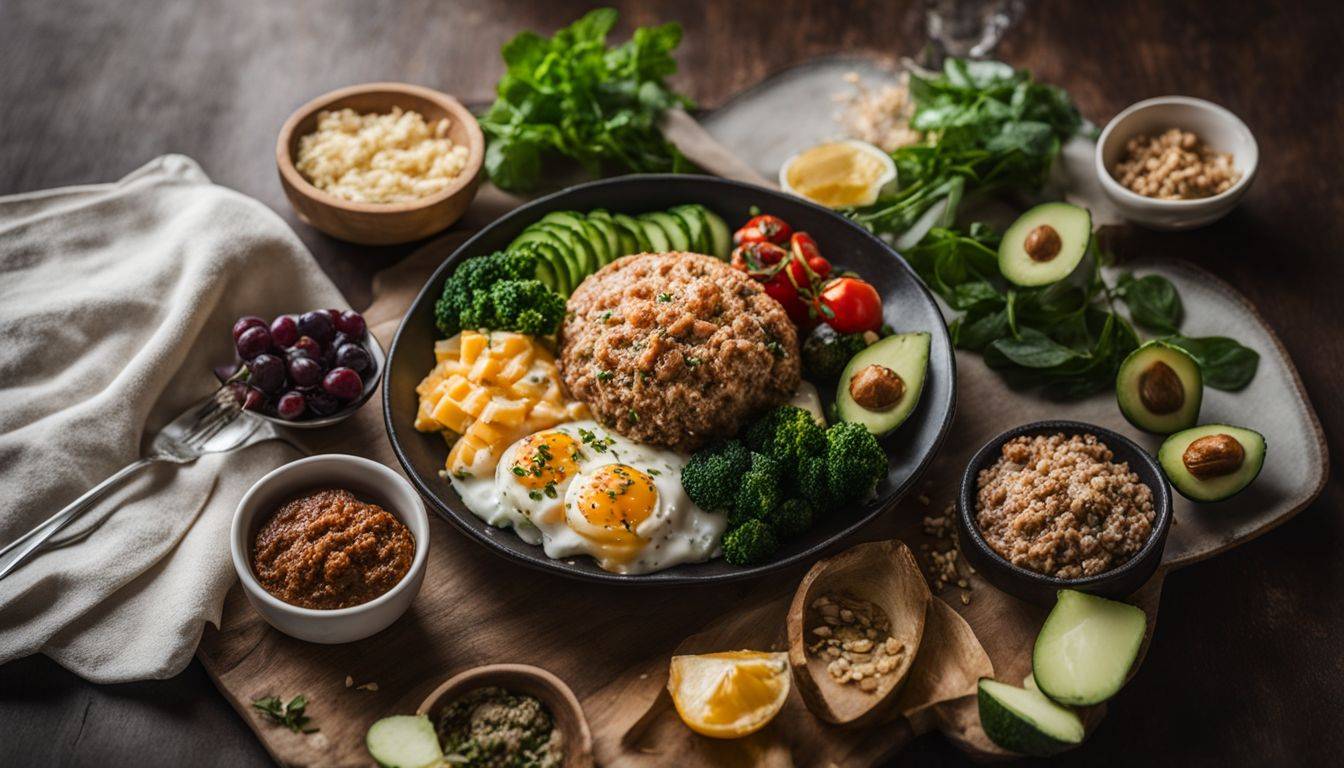Ever found yourself wrestling with the challenge of nudging your body into that elusive fat-burning state known as ketosis? Join the club, my friend. Just like you, I’ve spent significant time navigating this complex maze and hunting down effective tactics to quicken the process.
In this blog post, I’m all set to share eight tangible tips – from diet optimization to exercise routines – that promise to fuel your body’s transition into ketosis faster than ever before.
Trust me on this one – these game-changing strategies are truly worth exploring!
Key Takeaways
- To get into ketosis fast, minimize carb consumption and focus on eating more healthy fats like coconut oil.
- Increasing physical activity can help speed up the process of entering ketosis by depleting glycogen stores in the body.
- Trying a short fast or fat fast can kickstart your body’s ketone production and transition you into the ketogenic state faster.
- It’s important to maintain adequate protein intake while following a keto diet to support muscle growth and repair.
What is Ketosis?

Ketosis is a state your body enters. It happens when you don’t have enough carbs to use for energy. Instead, your body starts burning fat. This process makes things called ketones that it can use for fuel.
It’s not easy to get into ideal ketosis level, but there are ways to make it happen faster. You need to eat less carbs and more healthy fats like coconut oil. More physical activity also helps a lot! But don’t forget, too much protein might slow you down.
Stick with just the right amount of protein in your diet.
The keto diet is a low carb, high fat eating plan. You eat fewer carbs and more healthy fats. This changes how your body gets its energy. Your body starts to burn fat for fuel instead of carbs.
On this diet, not all fats are bad! Some fats, like those in coconut oil, help you get into ketosis faster. Ketosis is when your body burns fat for energy because it doesn’t have many carbs left.
Staying active also helps you reach ketosis quicker. So does fasting for short times or doing a “fat fast.” A “fat fast” means eating mostly fat for a few days to kick-start the process.
In all of these ways, the keto diet leads to less weight and better health!
Tips for Getting Into Ketosis Fast
To quickly enter ketosis, focus on minimizing carb consumption, including coconut oil in your diet, increasing physical activity, and maintaining adequate protein intake. Want to know more? Keep reading!
Related: Keto Diet For Beginners
Minimize carb consumption
To get into ketosis fast, cut carbs from your meal plan. The keto diet’s goal is to reduce carb intake a lot. Eating fewer carbs helps your body start burning fat for energy, which leads us into a state of ketosis.
Be careful not to cut out carbs and add more fats too fast though! It can be hard on beginners. So take small steps at first. Like they say – slow and steady wins the race! Stick with it, keep those net carbs low, and you’ll reach that fat-burning state before you know it.
Include coconut oil in your diet
Coconut oil is a great addition to your diet if you want to get into ketosis fast. It’s pure fat and doesn’t have any carbs, which is perfect for a low carb or ketogenic diet. The medium-chain triglycerides (MCTs) in coconut oil can help speed up the process of getting into ketosis.
These MCTs are special because they’re easily converted into ketones, which are used as an alternative energy source when you’re in ketosis. Consuming coconut oil can also aid in weight loss and help you shed pounds more quickly.
It contains four types of MCTs, including higher amounts of lauric acid, that offer various nutritional benefits and contribute to its effectiveness for weight management. So don’t forget to include coconut oil in your diet if you’re looking to reduce body fat or improve your overall health!
Increase physical activity
Increasing your physical activity is a great way to get into ketosis faster. When you exercise, it helps deplete the glycogen stores in your body, which triggers ketosis. This means that by being active, you can kickstart the process of burning fat for fuel instead of carbohydrates.
Short and intense bursts of energy exercises are particularly effective at depleting glycogen and promoting ketosis. Activities like high-intensity interval training or weightlifting can help you achieve this.
On the other hand, exercises that rely on carbohydrates may not be ideal if you’re trying to reach ketosis. However, low-intensity activities such as walking or light jogging can still increase your physical activity levels and support your goal of getting into ketosis faster.
Increase healthy fat intake
To get into ketosis faster, it’s important to increase your intake of healthy fats. Including foods like coconut oil and avocado in your diet can help speed up the process. Healthy fats are an essential part of the keto diet because they provide energy while keeping you feeling full.
They also support ketone production, which is what puts your body into a state of ketosis. So, by boosting your consumption of healthy fats, you can facilitate the transition into ketosis and start seeing results more quickly.
Try a short fast or fat fast
Getting into ketosis fast can be achieved by trying a short fast or fat fast. It helps kickstart your body’s ketone production and speeds up the transition to the ketogenic state. This method involves restricting calorie intake for a brief period, usually 24-48 hours, or consuming a diet that consists of mostly healthy fats. By doing so, your body quickly depletes its stored glycogen and starts utilizing fat for fuel, putting you on the path to ketosis faster. Just remember to consult with a healthcare professional before attempting any fasting or dramatic dietary changes.
- Start with a 24 – 48 hour fast, limiting calorie consumption during this time.
- Alternatively, try a fat fast by consuming mostly healthy fats for a designated period.
- Both methods help deplete glycogen stores and transition your body into the ketogenic state.
- Consult with a healthcare professional before attempting any fasting or significant dietary changes.
Maintain adequate protein intake
Maintaining adequate protein intake is crucial when trying to get into ketosis quickly. Protein consumption plays an important role in the body’s glucose needs while in ketosis. It helps support muscle growth and repair, ensuring that you maintain a healthy body composition as you lose weight.
The classic ketogenic diet emphasizes a moderate protein intake, but some resources suggest an average of 10-20% protein from total daily calories. So, make sure to include enough protein in your diet while following a keto plan to help your body achieve and sustain ketosis effectively.
Measuring Ketone Levels
There are multiple ways to measure ketone levels, including breath tests, urine tests, and blood tests.
Breath test
When it comes to measuring ketone levels in your body, a breath test is a simple and reliable option. It’s a noninvasive method that can be used to diagnose ketosis. With a breath test, you can measure the levels of acetone in your breath, which is responsible for the “fruity keto breath” often associated with being in ketosis.
A breath test is convenient and repeatable, making it an easy way to track your progress on the ketogenic diet. Historically, it has been used to monitor ketosis in both healthy individuals and those with diabetes.
By regularly testing your breath for ketones, you can ensure that you’re staying on track and reaching optimal levels of fat-burning metabolism.
Urine test
To measure ketone levels in your body, you can take a urine test. This test checks for the presence of ketones in your urine, which indicates whether or not you are in ketosis. Ketones are produced when your body breaks down fat for energy instead of carbohydrates.
The level of ketones in urine that shows you are in ketosis is measured in mg/dL (milligrams per deciliter). Keep in mind that while a urine test is convenient and easy to use, it may be less accurate than a blood test.
So if you want more precise results, consider using a blood or breath test instead.
Blood test
When it comes to measuring ketone levels, a blood test is the most reliable and accurate method. By using a blood ketone meter, you can determine if your body is in ketosis – that state where it burns fat for fuel instead of glucose.
This is especially important for individuals with type 1 diabetes, as high levels of ketones in the blood can indicate a serious condition called diabetic ketoacidosis. Additionally, monitoring your blood ketone levels allows you to keep track of your progress and ensure that you are maintaining ketosis effectively.
So, if you’re looking to reduce body fat or improve your overall health through the keto diet, don’t forget the importance of regular blood tests for accurate and precise measurement of your ketone levels.
Importance of Exercise

Exercise plays a vital role in achieving ketosis and improving overall health. When we exercise, our bodies use up the glucose stored in our muscles as energy. This depletion of glycogen helps to kickstart the process of entering ketosis, where our body starts burning fat for fuel instead of carbohydrates.
High-intensity exercises that push our limits may be more challenging while on a low-carb keto diet because our glycogen stores are reduced. However, engaging in prolonged or slow-paced endurance exercises can be particularly effective in speeding up the transition into ketosis.
Moreover, exercising in a fasted state promotes better fat burning and weight loss since ketosis occurs when we haven’t eaten for a certain period of time. By combining regular exercise with a proper low-carb diet and intermittent fasting, we can optimize the body’s ability to reach and maintain ketosis.
So let’s lace up those sneakers and get moving towards better fitness, improved endurance, and reaching our weight loss goals!
Conclusion
In conclusion, these 8 tips can help you get into ketosis fast. By reducing carbs, increasing activity, and trying fasting, you can speed up the process. Remember to include healthy fats in your diet and track your ketone levels for success on your ketogenic journey.
Start implementing these strategies today and reach your goals quicker!
